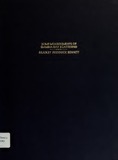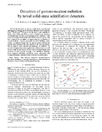Some measurements of gamma ray scattering
| dc.contributor.advisor | Evans, Robley D. | |
| dc.contributor.author | Bennett, Bradley Frederick. | |
| dc.date | August 1953 | |
| dc.date.accessioned | 2012-10-10T20:01:13Z | |
| dc.date.available | 2012-10-10T20:01:13Z | |
| dc.date.issued | 1953-08 | |
| dc.identifier.uri | https://hdl.handle.net/10945/14593 | |
| dc.description.abstract | This paper reports an investigation of the distribution of the energy, E, of the secondary electrons released in an organic scintillator by secondary gamma radiation measured on the same side of a scattering medium as that on which the source is located. The investigation was conducted by scintillation spectrometry using stilbene on an RCA 6199 photomultiplier, and employing the technique of Dr. C. J. Hine. The amplified detector output is analyzed by a differential discriminator of constant window width whose base line is continuously varied mechanically so as to scan the energy spectrum. The output is recorded by a counting rate meter and recording milliameter. Effectively semi-infinite scatterers of wood, aluminum, iron, tin and lead were used. The surface of the scatterer was always horizontal with its centerline always parallel to the source-detector line. The source-detector distance was kept at 40 cm while their distance, y, above the scatterer surface was varied from 0.5 cm to 90 cm. Essentially all of the secondary gammas originated in the scatterers because collimation was avoided. The primary beam was not excluded from the detector; the energy spectrum of the primary obtained with no scatterer was subtracted from that obtained with the scatterer in place. The difference was plotted. These data were presented in various ways to show the counting rate as a function of the other three prime variables, E, Y, and Z (atomic number of the scatterer). Auxiliary experiments were run in the same manner measuring effects of reducing the surface area of a scatterer, changing the primary gamma-ray energy from the mean od 1.25 Mev from Co(60) to 0.663 Mev from Cs (137), and changing the thickness of one of the scatterers. A qualitative discussion is presented for each part of the investigation, explaining as far as possible the significant features of the data ssuch as maxima and cariations in intensity observed, and attempting to correlate them with the prime variables. A relation to the density of the scatterers is also inferred. By consideration of the angular distribution shown is Compton-Rayleigh scattering, and by taking into account the absorption of the scattered gammas by photoelectric effect in high Z materials, satisfactory explanations are found for most of the observed phenomena on the basis of existing knowledge. A few features, however, require further observations for verification and clarification. | en_US |
| dc.description.uri | http://archive.org/details/somemeasurements1094514593 | |
| dc.language.iso | en_US | |
| dc.publisher | Cambridge, Massachusetts; Massachusetts Institute of Technology | en_US |
| dc.subject.lcsh | Nuclear physics | en_US |
| dc.title | Some measurements of gamma ray scattering | en_US |
| dc.type | Thesis | en_US |
| dc.contributor.corporate | Massachusetts Institute of Technology | |
| dc.contributor.department | Department of Physics | |
| dc.description.service | Commander, United States Navy | en_US |
| etd.thesisdegree.name | M.S. in Physics | en_US |
| etd.thesisdegree.level | Masters | en_US |
| etd.thesisdegree.discipline | Physics | en_US |
| etd.thesisdegree.grantor | Massachusetts Institute of Technology | en_US |
| dc.description.distributionstatement | Approved for public release; distribution is unlimited. |
Files in this item
This item appears in the following Collection(s)
-
1. Thesis and Dissertation Collection, all items
Publicly releasable NPS Theses, Dissertations, MBA Professional Reports, Joint Applied Projects, Systems Engineering Project Reports and other NPS degree-earning written works.





